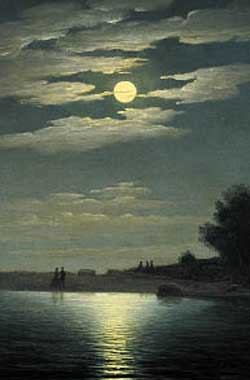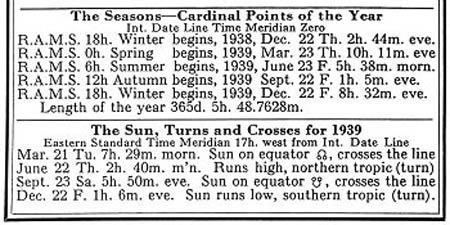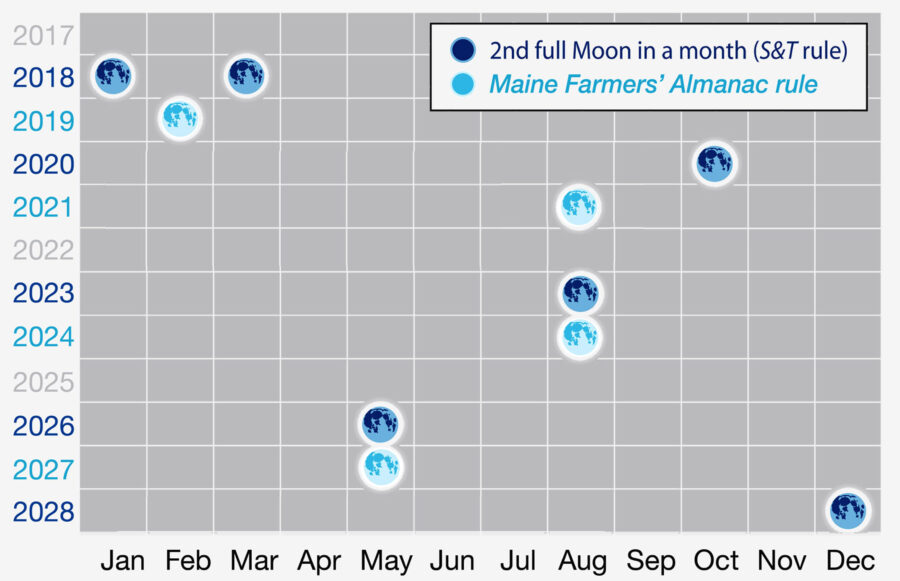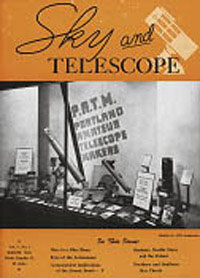Recent decades have seen widespread popular embrace of the "Blue Moon," defined as the second full Moon in a calendar month. Countless news outlets have run stories about Blue Moons.

The notion of a "blue Moon," meaning "rare," can be traced back hundreds of years. But in an article entitled "Once in a Blue Moon," folklorist Philip Hiscock traced the calendrical meaning of the term "Blue Moon" to more recent times, namely to the Maine Farmers' Almanac for 1937. Yet the almanac does not use the second-full-Moon-in-a-month definition that most news outlets quote today.
With help from Margaret Vaverek (Southwest Texas State University) and several other librarians, we obtained more than 40 editions of the Maine Farmers' Almanac from the period 1819 to 1962. These refer to more than a dozen Blue Moons, and not one of them is the second full Moon in a month. So where did that meaning come from?
How Often Do Blue Moons Happen?
Several clues point to a strong connection between the almanac's Blue Moons and the four seasons of the year. All of the listed Blue Moons fall on the 20th, 21st, 22nd, or 23rd day of November, May, February, or August. These blue moon dates fall about a month before the Northern Hemisphere winter and summer solstices, and spring and fall equinoxes, respectively, which occur on similar day numbers.
Although the idea of a seasonal pattern suggested itself to us immediately, verifying the details required a lot of detective work. We found that the Blue Moon definition employed in the Maine Farmers' Almanac is indeed based on the seasons, but with some subtle twists.
Instead of the calendar year running from January 1st through December 31st, the almanac relies on the tropical year, defined as extending from one winter solstice ("Yule") to the next. Most tropical years contain 12 full Moons — three each in winter, spring, summer, and fall — and each is named for an activity appropriate to the time of year (such as the Harvest Moon in autumn). But occasionally a tropical year contains 13 full Moons, such that one season has four rather than the usual three.

Today we usually mark the beginning of the seasons when the Sun's celestial longitude passes 0° (spring), 90° (summer), 180° (autumn), and 270° (winter). The Sun appears to move along the ecliptic at a variable rate because of the Earth's not-quite-circular orbit, so the seasons defined this way are not equal in duration. Another approach uses the dynamical mean Sun or fictitious mean Sun — imaginary bodies that move along the ecliptic and the celestial equator, respectively, at a constant rate and produces seasons of equal length. The Maine almanac defines the seasons using this alternative method.
The almanac also follows certain rules laid down as part of the Gregorian calendar reform in 1582. The ecclesiastical vernal (spring) equinox always falls on March 21st, regardless of the position of the Sun. Lent begins on Ash Wednesday, 46 days before Easter, and must contain the Lenten Moon, considered to be the last full Moon of winter. The first full Moon of spring is called the Egg Moon (or Easter Moon, or Paschal Moon) and must fall within the week before Easter.

Sky & Telescope
At last we have the “Maine rule” for Blue Moons: Seasonal Moon names are assigned near the spring equinox in accordance with the ecclesiastical rules for determining the dates of Easter and Lent. The beginnings of summer, fall, and winter are determined by the dynamical mean Sun. When a season contains four full Moons, the third is called a Blue Moon.
Why is the third full Moon identified as the extra one in a season with four? Because only then will the names of the other full Moons, such as the Moon Before Yule and the Moon After Yule, fall at the proper times relative to the solstices and equinoxes.
What Is A Blue Moon: Questions and Answers
During the period 1932 to 1957, under the editorship of Henry Porter Trefethen (1887-1957), the Maine Farmers' Almanac consistently listed Blue Moons derived from the convoluted seasonal rule just described. So where did the modern convention — that a Blue Moon is the second full Moon in a calendar month — come from? Sky & Telescope has, and is, the answer!
Laurence J. Lafleur (1907-66) of Antioch College, Ohio, discussed Blue Moons in a question-and-answer column in Sky & Telescope, July 1943, page 17, citing the 1937 Maine Farmers' Almanac as his source. It is clear that Lafleur had a copy of the almanac at his side as he wrote, since he quoted word for word the commentary on the August 1937 calendar page. This commentary notes that the Moon occasionally "comes full thirteen times in a year," but Lafleur did not judge whether this referred to a tropical year or a calendar year. More important, he did not mention the specific dates of any Blue Moons and never said anything about two full Moons in one calendar month.
Oops!

Some three years later, in March 1946, an article entitled "Once in a Blue Moon" appeared in Sky & Telescope (page 3). Its author, James Hugh Pruett (1886-1955), was an amateur astronomer living in Eugene, Oregon, and a frequent contributor to Sky & Telescope. Pruett wrote on a variety of topics, especially fireball meteors. In his article on Blue Moons, he mentioned the 1937 Maine almanac and repeated some of Lafleur's earlier comments. Then he went on to say, "Seven times in 19 years there were — and still are — 13 full moons in a year. This gives 11 months with one full moon each and one with two. This second in a month, so I interpret it, was called Blue Moon."
Pruett must not have had the 1937 almanac handy, or he would have noticed that the Blue Moon fell on August 21st (obviously not the second full Moon that month) and that 1937 had only 12 full Moons. But only in retrospect is his error so obvious.
Modern Folklore
Sky & Telescope adopted Pruett's new definition, using it in a note entitled "'Blue' Moons in May" on page 176 of the May 1950 issue. In a bizarre twist, the data on lunar phases for this note came from none other than H. Porter Trefethen of Winthrop, Maine, editor of the very almanac Pruett misread four years earlier! But Trefethen himself never called the second full Moon in a month a Blue Moon. The "'Blue' Moons" headline was likely added by Sky & Telescope's founding editor, Charles A. Federer Jr. Federer agreed that he probably wrote that headline with Pruett's then-recent article in mind and without consulting Trefethen.
As Hiscock explained in the March issue, the popular radio program StarDate on January 31, 1980, also uses the second-full-moon-in-a-month definition. We examined the show's script, authored by Deborah Byrd, and found that it contains a footnote not read on the air that cites Pruett's 1946 article as the source for the information. A version of the game Trivial Pursuit published in 1986 further popularized this definition. (Indeed, a Google Ngram shows that the term "blue Moon" itself became much more widely used after 1986.)
With two decades of popular usage behind it, the second-full-Moon-in-a-month (mis)interpretation is like a genie that can't be forced back into its bottle. But that's not necessarily a bad thing. Those with the sunniest outlooks will celebrate twice. Why not treat Blue Moons as marking both the second full Moon in a calendar month and the third full Moon in a season with four?
"Even if the calendrical meaning is new," said Federer, "I don't see any harm in it. It's something fun to talk about, and it helps attract people to astronomy."
 0
0








Comments
You must be logged in to post a comment.